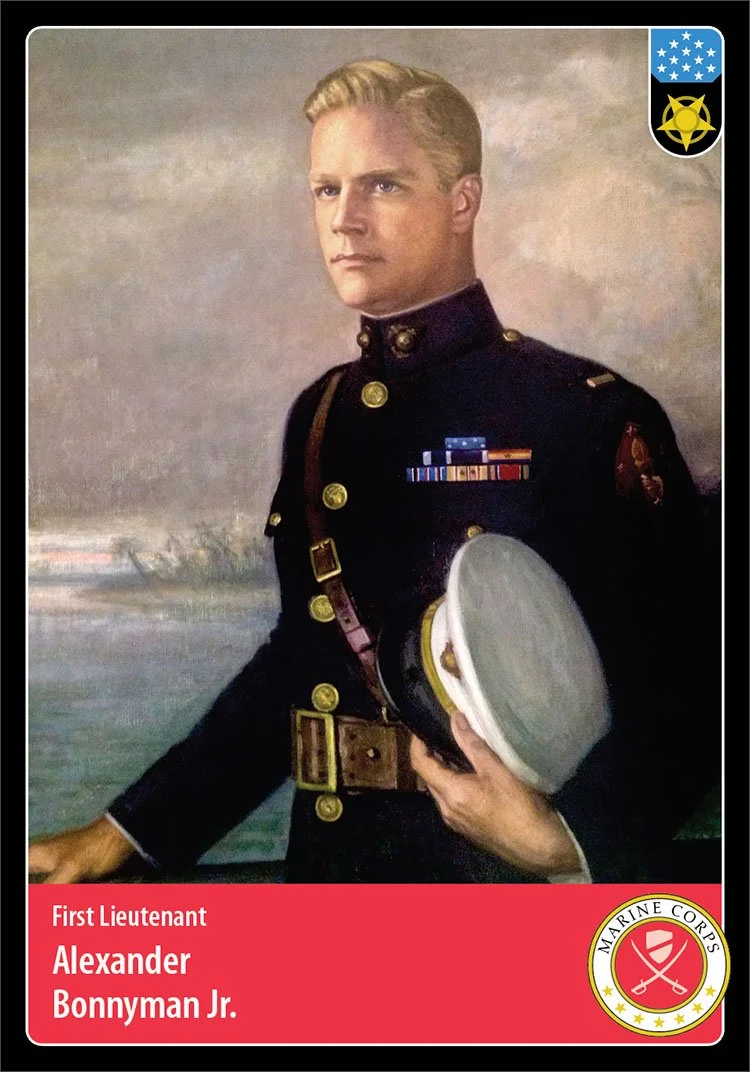Hero Card 121, Card Pack 11
Oil painting by Arturo Noci, 1944 (provided by Clay Bonnyman Evans)
Hometown: Knoxville, TN
Branch: U.S. Marine Corps
Unit: Company F, 2nd Battalion, 18th Marines, 2nd Marine Division
Military Honors: Medal of Honor, Purple Heart
Date of Sacrifice: November 22, 1943 - KIA on Betio Island, Tarawa Atoll, Gilbert Islands, Kiribati
Age: 33
Conflict: World War II, 1939-1945
Alexander “Sandy” Bonnyman Jr. was born in Atlanta, Georgia on May 2, 1910, to Alexander and Frances Bonnyman. The family moved to Knoxville, Tennessee when Alexander Jr. was two years old, his father taking a position as president of Knoxville’s Blue Diamond Coal Company.
The younger Bonnyman attended Thackston’s School in Knoxville, then moved to Lakewood, New Jersey, to finish high school at Newman School. He enrolled at New Jersey’s Princeton University in 1928, where he played football and studied engineering.
Bonnyman left Princeton after his sophomore year. According to his daughter, Fran, “He wanted to go to the service. He loved Princeton, but he wanted to do something for his country.”
He enlisted in the Army Air Corps in June of 1932, but his time as a Flying Cadet was brief. After three months in Preflight School at Randolph Field near San Antonio, Texas, Bonnyman was honorably discharged for “flying deficiency.”
During his time at Randolph Field, Bonnyman met San Antonian Josephine Bell at a debutante party. The two were married in February of 1933. He worked for his father’s coal mining business until 1938, when he bought his own copper mine in the mountains near Santa Fe, New Mexico, and moved his young family there.
Family members recall that Alexander Bonnyman was shaken by the news of the Japanese attack on Pearl Harbor on December 7, 1941.
Bonnyman would have qualified for a draft exemption as a parent, and as the owner of a copper mine—as copper was essential to the war effort. But his desire to do more for his country compelled him to join the U.S. Marine Corps in July of 1942.
This time his military service went differently. Bonnyman saw combat in the Guadalcanal Campaign in the South Pacific, and his actions earned him an unusual battlefield commission to Second Lieutenant in February of 1943. Six months later, he was promoted to First Lieutenant. In November of 1943, he and the 18th Marines, 2nd Marine Division were sent to Tarawa Atoll in the Gilbert islands, which was heavily fortified by the Japanese.
When the Marines hit the beaches on the small island of Betio in the Tarawa Atoll, they faced intense artillery and sniper fire from Japanese pillboxes. Many American soldiers were stopped short as their landing craft were stuck on reefs. Of those who did land, many were cut down as they ran exposed on the beaches.
As an executive officer for the Second Battalion Shore Party, Lt. Bonnyman had no direct combat responsibilities. In the chaos, he took charge and put together an assault team, leading them on a desperate attack on the strongly defended enemy emplacements. Lt. Bonnyman planned and led the assault with a team of 21 engineers and riflemen. The plan was dubbed “Forlorn Hope” due to the hopelessness of their mission.
Stars and Stripes magazine recounts that Bonnyman’s men “charged the bunker and killed a machine gunner perched on top with satchel charge demo devices and flamethrowers. On the summit, they dropped explosive charges down the ventilator openings and sprayed inside the bunker with flaming diesel fuel. More than 100 Japanese troops were flushed from the blockhouse and immediately killed. About 150 died inside the bunker. Bonnyman, then 33, made a heroic last stand as he was mortally wounded.”
According to Marine historian Col. Joseph Alexander, Bonnyman’s actions “almost single-handedly ended the stalemate on Red Beach Three.”
For his courage and leadership at Tarawa, Lr. Alexander Bonnyman was posthumously awarded the Congressional Medal of Honor. The Medal was presented to his daughter, Fran, by Secretary of the Navy James F. Forrestal during ceremonies at the Navy Department, Washington, D.C., on January 22, 1947.
As was often the case after intense battles, the U.S. Marine Corps would hastily bury fallen soldiers and mark the sites for later retrieval and return to the families. At Tarawa, many of the markers were lost, and the locations of the buried—including Lt. Bonnyman—unknown for decades.
Bonnyman was listed as missing, and other records mistakenly reported that he’d been buried at sea. In May of 2015—72 years after Lt. Bonnyman’s heroic stand—his remains were discovered on Betio island and verified by a team of researchers from the non-profit organization History Flight, working with the Defense POW/MIA Accounting Agency.
One of the volunteers on the mission that discovered Bonnyman’s remains was Clay Bonnyman Evans—Lt. Bonnyman’s grandson. Evans recounts his grandfather’s story in his book, Bones of My Grandfather: Reclaiming a Lost Hero of World War II.
Lt. Alexander “Sandy” Bonnyman Jr. was returned home and laid to rest with military honors at Berry Highland Memorial Cemetery in Knoxville, Tennessee, on September 27, 2015.
In Honolulu Hawaii, Lt. Alexander Bonnyman Jr.’s name is engraved on the American Battle Monument Commission’s “Courts of the Missing” (Pillar IX, Top Panel) along with the others who are missing from World War II. As is the custom, a rosette has been placed next to his name to indicate that he has been found.
Sources
Oil painting by Arturo Noci, 1944, provided by Clay Bonnyman Evans (Lt. Bonnyman’s grandson)
Details submitted by the East Tennessee Veterans Memorial Association
East Tennessee Veterans Memorial Association: Alexander Bonnyman Jr.
Marine Corps University: First Lieutenant Alexander Bonnyman, Jr., USMCR (Deceased)
Congressional Medal of Honor Society: Alexander “Sandy” Bonnyman Jr.
Naval History and Heritage Command: Bonnyman, Alexander, Jr.
Princeton Alumni Weekly: Issue in doubt
Marines.mil: 1st Lt. Alexander Bonnyman Jr. Returns Home From Tarawa
Stars and Stripes: Man behind the medal: Grandson’s book offers warts-and-all view of WWII hero
Burial Site: Find a Grave





